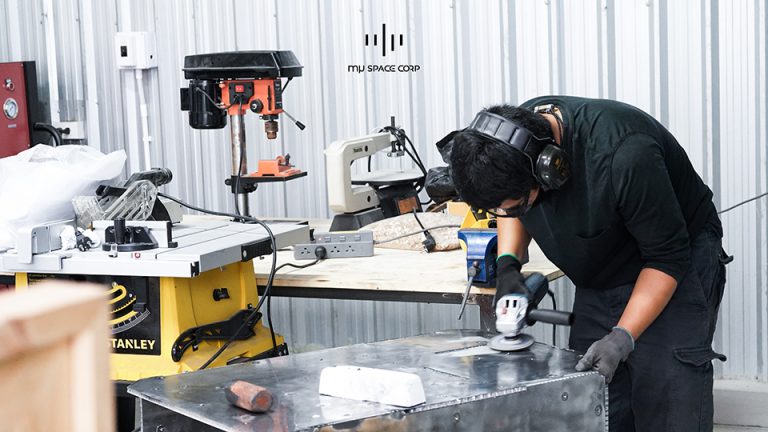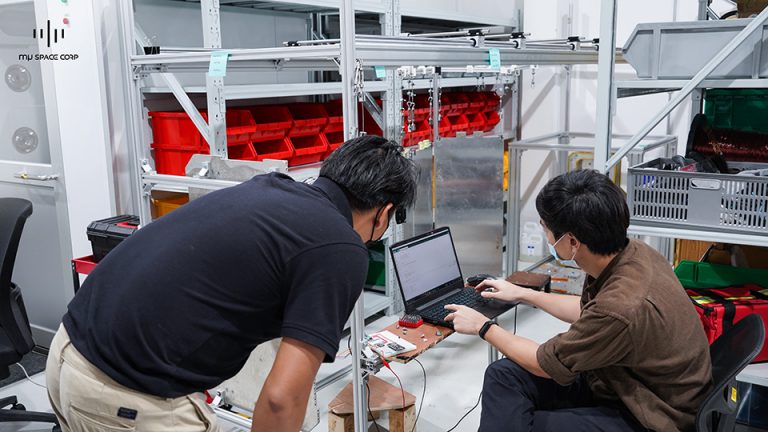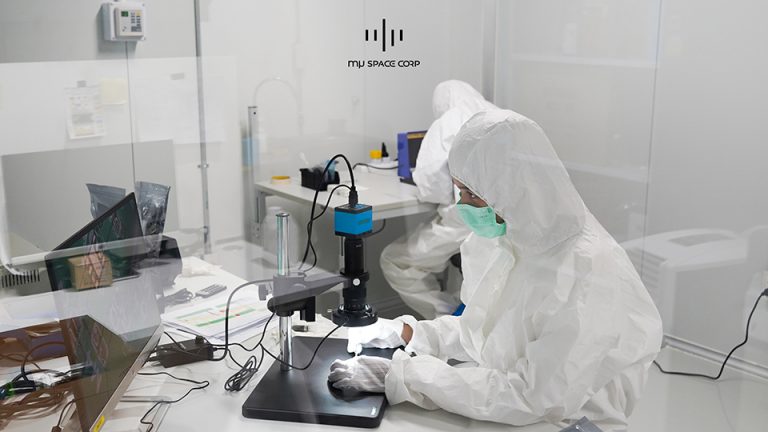The key element for any manufacturing factory is their production and their product. The product will always represent the system in which created it. If the system is faulty, then the product will also be either broken or dysfunctional. A vertically integrated strategy, if affordable, could be the most promising blueprint to adopt. In this article, we will explore the mechanisms that go into a vertically integrated system and how it could benefit many businesses, especially those creating products with very low margins for error. Mu Space, the first-ever aerospace company in South East Asia, adopts the vertical integration strategy because quality control and high performance are of paramount importance to the company.
 A vertically integrated company, just like the name suggests, does everything from top to bottom or, in this case, from the bottom to top. The company, often a manufacturing company, will helm every process of production, from spare parts to the final structure itself. This system relies heavily on manpower and quality control. A company adopting this system will have experts in every niche department, as doing every process in-house requires leading personalities in each sector. Job creation, therefore, can also be seen as another positive in the adoption of a vertically integrated strategy.
So how effective is the vertical integration strategy?
To answer this, one can observe the mu Space production model. Mu Space just launched its latest satellite, MU-B200, a high-performing and high-powered satellite set to provide rapid telecommunication connectivity. All the components used to build this satellite were created by mu Space and its leading engineers. Everything from the nanotech composites that go in the battery, to the krypton thrusters and solar panels were are all created in-house by mu Space. All the components created go through an extensive observation and test phase to make sure that the quality is at its best. This process is only possible due to the vertical integration strategy, as creating everything in-house also gives the production team a chance to monitor quality at every phase. Unlike buying components from a supplier, in that case, the company would not be able to monitor every phase of production.
A vertically integrated company, just like the name suggests, does everything from top to bottom or, in this case, from the bottom to top. The company, often a manufacturing company, will helm every process of production, from spare parts to the final structure itself. This system relies heavily on manpower and quality control. A company adopting this system will have experts in every niche department, as doing every process in-house requires leading personalities in each sector. Job creation, therefore, can also be seen as another positive in the adoption of a vertically integrated strategy.
So how effective is the vertical integration strategy?
To answer this, one can observe the mu Space production model. Mu Space just launched its latest satellite, MU-B200, a high-performing and high-powered satellite set to provide rapid telecommunication connectivity. All the components used to build this satellite were created by mu Space and its leading engineers. Everything from the nanotech composites that go in the battery, to the krypton thrusters and solar panels were are all created in-house by mu Space. All the components created go through an extensive observation and test phase to make sure that the quality is at its best. This process is only possible due to the vertical integration strategy, as creating everything in-house also gives the production team a chance to monitor quality at every phase. Unlike buying components from a supplier, in that case, the company would not be able to monitor every phase of production.
 The production phase isn’t the only positive aspect of a vertical integration strategy, job creation is another plus point. Companies like mu Space that adopt this model can create various job positions within the company itself. From engineers to designers and cleaners, this model can create jobs for every employee on the spectrum. Mu Space is about to reach 150 employees and has opened one factory this year, with another factory already announced.
The production phase isn’t the only positive aspect of a vertical integration strategy, job creation is another plus point. Companies like mu Space that adopt this model can create various job positions within the company itself. From engineers to designers and cleaners, this model can create jobs for every employee on the spectrum. Mu Space is about to reach 150 employees and has opened one factory this year, with another factory already announced.
 The strategy also allows a solid trust to form between mu Space and its clients. Since clients will be aware that mu Space is taking quality as a paramount concern in every phase of production, therefore, clients can feel safe that any product they purchase is in its optimal form. With the introduction of nanotechnology to their products, mu Space ever more is looking to expand its roster of leading engineers and employees.
The strategy also allows a solid trust to form between mu Space and its clients. Since clients will be aware that mu Space is taking quality as a paramount concern in every phase of production, therefore, clients can feel safe that any product they purchase is in its optimal form. With the introduction of nanotechnology to their products, mu Space ever more is looking to expand its roster of leading engineers and employees.
 A vertically integrated company, just like the name suggests, does everything from top to bottom or, in this case, from the bottom to top. The company, often a manufacturing company, will helm every process of production, from spare parts to the final structure itself. This system relies heavily on manpower and quality control. A company adopting this system will have experts in every niche department, as doing every process in-house requires leading personalities in each sector. Job creation, therefore, can also be seen as another positive in the adoption of a vertically integrated strategy.
So how effective is the vertical integration strategy?
To answer this, one can observe the mu Space production model. Mu Space just launched its latest satellite, MU-B200, a high-performing and high-powered satellite set to provide rapid telecommunication connectivity. All the components used to build this satellite were created by mu Space and its leading engineers. Everything from the nanotech composites that go in the battery, to the krypton thrusters and solar panels were are all created in-house by mu Space. All the components created go through an extensive observation and test phase to make sure that the quality is at its best. This process is only possible due to the vertical integration strategy, as creating everything in-house also gives the production team a chance to monitor quality at every phase. Unlike buying components from a supplier, in that case, the company would not be able to monitor every phase of production.
A vertically integrated company, just like the name suggests, does everything from top to bottom or, in this case, from the bottom to top. The company, often a manufacturing company, will helm every process of production, from spare parts to the final structure itself. This system relies heavily on manpower and quality control. A company adopting this system will have experts in every niche department, as doing every process in-house requires leading personalities in each sector. Job creation, therefore, can also be seen as another positive in the adoption of a vertically integrated strategy.
So how effective is the vertical integration strategy?
To answer this, one can observe the mu Space production model. Mu Space just launched its latest satellite, MU-B200, a high-performing and high-powered satellite set to provide rapid telecommunication connectivity. All the components used to build this satellite were created by mu Space and its leading engineers. Everything from the nanotech composites that go in the battery, to the krypton thrusters and solar panels were are all created in-house by mu Space. All the components created go through an extensive observation and test phase to make sure that the quality is at its best. This process is only possible due to the vertical integration strategy, as creating everything in-house also gives the production team a chance to monitor quality at every phase. Unlike buying components from a supplier, in that case, the company would not be able to monitor every phase of production.
 The production phase isn’t the only positive aspect of a vertical integration strategy, job creation is another plus point. Companies like mu Space that adopt this model can create various job positions within the company itself. From engineers to designers and cleaners, this model can create jobs for every employee on the spectrum. Mu Space is about to reach 150 employees and has opened one factory this year, with another factory already announced.
The production phase isn’t the only positive aspect of a vertical integration strategy, job creation is another plus point. Companies like mu Space that adopt this model can create various job positions within the company itself. From engineers to designers and cleaners, this model can create jobs for every employee on the spectrum. Mu Space is about to reach 150 employees and has opened one factory this year, with another factory already announced.
 The strategy also allows a solid trust to form between mu Space and its clients. Since clients will be aware that mu Space is taking quality as a paramount concern in every phase of production, therefore, clients can feel safe that any product they purchase is in its optimal form. With the introduction of nanotechnology to their products, mu Space ever more is looking to expand its roster of leading engineers and employees.
The strategy also allows a solid trust to form between mu Space and its clients. Since clients will be aware that mu Space is taking quality as a paramount concern in every phase of production, therefore, clients can feel safe that any product they purchase is in its optimal form. With the introduction of nanotechnology to their products, mu Space ever more is looking to expand its roster of leading engineers and employees.







